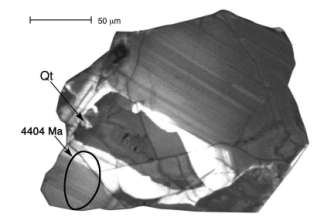 [At
right: Scientists believe that this zircon grain, determined to be 4.4
billion years old, is the oldest terrestrial material on Earth. John Valley]
[At
right: Scientists believe that this zircon grain, determined to be 4.4
billion years old, is the oldest terrestrial material on Earth. John Valley]
| Geotimes Home | Calendar | Classifieds | Subscribe | Advertise |
| Geotimes
Published by the American Geological Institute |
February
2001
Newsmagazine of the Earth Sciences |
Rethinking early Earth
Scientists have found that Earth may have cooled to temperatures low enough to allow crustal materials to form only 100 million years after Earth first accreted. A tiny grain of zircon discovered in Western Australia exhibits an oxygen isotope ratio high enough to indicate that the mineral must have formed in a relatively cool environment at Earth’s surface approximately 4.4 billion years ago.
John Valley of the University of Wisconsin-Madison, William Peck of Colgate University and Colin Graham of the University of Edinburgh have worked together to analyze the ancient zircon grain found by Simon Wilde of Curtin University in Perth, Australia. If the zircon is indeed a rare remnant of primitive Earth, scientists may have to rethink their belief that an ocean of magma dominated the first 700 million years of the planet’s geologic history. Their zircon dates show that Earth had to have cooled to approximately 100 degrees Celsius within a fraction of that time in order for crystal formation to occur. Valley and his colleagues published their work in the Jan. 11 Nature.
 [At
right: Scientists believe that this zircon grain, determined to be 4.4
billion years old, is the oldest terrestrial material on Earth. John Valley]
[At
right: Scientists believe that this zircon grain, determined to be 4.4
billion years old, is the oldest terrestrial material on Earth. John Valley]
The scientists consider the giant meteorite that crashed into Earth approximately 4.45 billion years ago one of many cataclysmic events that occurred during Earth’s first one billion years of history. If the zircon were 4.4 billion years old, it would have formed during the period when Earth was bombarded by a fusillade of meteorites. Most likely it formed during a short period of geologic quiescence when the surface cooled enough to allow oceans to condense.
Water-rock interactions are indicated by the high oxygen-18 content
of the zircon grain. The oxygen isotope ratio is sensitive to low-temperature
interactions between
rocks and water, Peck explains. “We don’t actually know which process
this is, but whatever the source of the granites was had some interaction
... and the most common and largest-scale process is water interaction,”
he says.
LW
Model mood-swings
In a climate model that created its own "what if?" scientists found
they did not have to add any external forces — such as volcanic eruptions
or human-induced climate changes — to create an abrupt cooling of the North
Atlantic Ocean. Alex Hall of Lamont-Doherty Earth Observatory and Ronald
Stouffer of NOAA's Geophysical Fluid Dynamics Laboratory ran a 15,000-year
simulation of the present-day climate and, 3,100 years into the model,
got a cold spell lasting 30-40 years. They trailed the blip in the model
back to an unusual duration of northwesterly winds over Greenland. The
winds intensified the East Greenland current, which brings Arctic fresh
water along Greenland's coast to the North Atlantic. The cooler water would
hinder surface warming and circulation, chilling overlaying atmosphere.
The researchers reported their findings in the Jan. 11 Nature.
CR
Russia to store nuclear waste
Russia will bring more fuel into its country — although it’s not the sort that will bring heat to homes. It’s nuclear waste that Russia plans to reprocess as the first part of a plan that could bring the country $20 billion and 21,000 tons of nuclear waste.
Russian lawmakers voted to overturn a 1992 law that forbids nuclear waste imports from countries that were not former Eastern Bloc nations and accept waste from other nations. Leaders expect that European and Asian countries will make the most of this new policy, emptying temporarily stored nuclear waste into armored trains that will carry the waste into the Ural Mountains in central Russia.
The Russian Atomic Energy Ministry says that it plans to use the money
that the country will receive over the next 10 years to clean up existing
radioactive spills. The Ministry adds that the plan is a good way to take
advantage of Russia’s Cold War-era nuclear and scientific facilities.
LW
 |
Geotimes Home | AGI Home | Information Services | Geoscience Education | Public Policy | Programs | Publications | Careers |